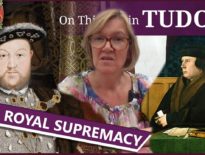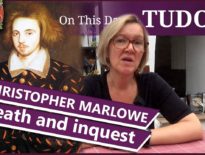On this day in Tudor history, 2nd June 1536, Jane Seymour made her first public appearance at Greenwich Palace.
She'd married King Henry VIII on 30th May 1536, and this public appearance was just two weeks after Anne Boleyn's execution, so it must have caused quite a stir.
Find out more about this public appearance, and also about Jane Seymour herself, in today's talk.
Also on this day in Tudor history, 2nd June 1572, thirty-four-year-old Thomas Howard, 4th Duke of Norfolk, was beheaded on Tower Hill for high treason. Norfolk was a Knight of the Garter, he'd served as Earl Marshal and Lord High Steward, he'd presided over Queen Elizabeth I's coronation, so what had led him to this sticky end and how was he involved with Mary, Queen of Scots? Find out in last year’s video:
Also on this day in history:
- 1535 – Death of Sir Humphrey Coningsby, judge.
- 1536 – Death of John Stewart (Stuart), 2nd Duke of Albany, at his château of Mirefleur in the Auvergne.
- 1537 – Executions of rebels Sir Francis Bigod, George Lumley and Sir Thomas Percy after Bigod's Rebellion in the aftermath of the Pilgrimage of Grace.
- 1567 – Death of Shane O'Neill, Irish chieftain. He was killed by the Scots who cut his throat.
- 1581 – Execution of James Douglas, 4th Earl of Morton and former regent of Scotland, for treason. He was executed in Edinburgh, at the cross, by the "maiden", a type of guillotine.
- 1595 – Death of William Wickham, Bishop of Winchester, at Winchester House, Southwark - either this date or 12th June.
- 1609 – Burial of Elizabeth Russell (née Cooke), Lady Russell, linguist and courtier. She was buried at Bisham Church. She was the daughter of Sir Anthony Cooke and wife of Sir Thomas Hoby and then, after his death, Lord John Russell.
- 1626 – Death of Sir Edward Bromley, judge.
- 1636 – Death of Theophilus Field, Bishop of Hereford. He was buried at Hereford Cathedral.
Transcript:
On this day in Tudor history, 2nd June 1536, Jane Seymour, who had married King Henry VIII on 30th May 1536, made her first public appearance at Greenwich Palace.
Jane’s predecessor, Queen Anne Boleyn, had been executed on 19th May 1536, just two weeks earlier, so Jane’s first appearance as queen must surely have caused some tongues to wag. Everything had happened so very fast.
Here is an extract from Sir John Russell’s letter to Arthur Plantagenet, Lord Lisle and Lord Deputy of Calais, about Jane appearing as queen:
“On Friday last the Queen sat abroad as Queen, and was served by her own servants, who were sworn that same day. The King came in his great boat to Greenwich that day with his privy chamber, and the Queen and the ladies in the great barge. I assure you she is as gentle a lady as ever I knew, and as fair a Queen as any in Christendom. ‘The King hath come out of hell into heaven for the gentleness in this and the cursedness and the unhappiness in the other.’ You would do well to write to the King again that you rejoice he is so well matched with so gracious a woman as is reported. This will please the King.”
In his chronicle, Edward Hall simply states that Jane was “openlye shewed as Quene” at Whitsuntide, Whitsun being 4th June that year. Charles Wriothesley, chronicler and Windsor Herald, states that Jane was officially proclaimed queen at Greenwich on 4th June 1536. Whether it was 2nd or 4th June, it was around Whitsun that Jane made this first public appearance as Henry VIII’s new wife and queen consort.
Who was Jane?
Well, she was the daughter of Sir John Seymour of Wulfhall, and his wife, Margery Wentworth, and the sister of Edward Seymour and Thomas Seymour, who were both courtiers on the rise in the 1530s. Jane had served as a maid of honour to Catherine of Aragon and was serving Anne Boleyn as a maid of honour in early 1536 when the king noticed her. The first mention we have on her with regards to a flirtation with the king is 10th February 1536, when imperial ambassador Eustace Chapuys recorded Anne Boleyn’s miscarriage and wrote of the treatment that Jane was receiving from the king, which involved him recently making “great presents”.
Chapuys later recorded that Jane was being “well tutored” by the king’s courtiers who hated Anne, the Catholic conservatives who were supporters of the king’s daughter, Mary. According to Chapuys, they were telling Jane not “to give in to the King’s fancy unless he makes her his Queen, upon which the damsel is quite resolved” and they also advised her to “tell the King frankly, and without reserve, how much his subjects abominate the marriage contracted with the concubine, and that not one considers it legitimate.”
Of course, we don’t know what Jane did tell the king, but when he sent her a purse of sovereigns with a letter, Jane gave it back to the messenger and told him to tell the king that she valued her honour and “if the King wished to make her a present of money, she requested him to reserve it for such a time as God would be pleased to send her some advantageous marriage”.
That advantageous marriage turned into being one with the king, and, of course, this time, the king only had to wait a few months to be married, rather than six years like last time.



Leave a Reply